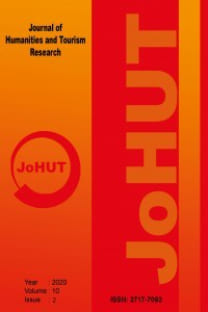A Statistical Approach to Improve the Standard Setting Process: Cluster Analysis
Cluster analysis, k-means, passing score
___
- Alpar, R. (2011). Uygulamalı Çok Değişkenli İstatistiksel Yöntemler. Ankara: Detay Yayıncılık Downing, S. M., Tekian, A. & Yudkowsky, R. (2006). Research Methodology: Procedures forEstablishing Defensible Absolute Passing Scores on Performance Examinations in Health Professions Education. Teaching and Learning in Medicine, 18 (1), 50–57. Retrieved from http://www.ncbi.nlm.nih.gov/pubmed/16354141 Ebel, R. L. (1972). Essentials of Educational Measurement. New Jersey: Prentice Hall. Gündeğer, C. (2012). Angoff, Yes/No ve Ebel Standart Belirleme Yöntemlerinin Karşılaştırılması (Master’s Thesis, Hacettepe Üniversitesi, Ankara, Turkey) Retrieved from https://tez.yok.gov.tr/UlusalTezMerkezi/ Hess, B., Subhiyah, R. G. & Giordano, C. (2007). Convergence between cluster analysis and the Angoff method for setting minimum passing scores on credentialing examinations. Evaluation and the Health Professions, 30, 362-375. Retrieved from http://www.ncbi.nlm.nih.gov/pubmed/17986670 Jaeger, R. M. (1989). Certification of student competence. In R. L. Linn (Ed.), Educational measurement (pp. 485–514). Washington, DC: American Council on Education. Khalid, M. N. (2011). Cluster analysis–a standard setting technique in measurement and testing. Journal of Applied Quantitative Methods, 6, 46–58. Retrieved from http://www.jaqm.ro/issues/volume-6,issue 2/pdfs/6_khalid_shafiq_khan.pdf Livingston, S. A. & Zieky, M. J. (1982). Passing Scores (A Manual for Setting Standards of Performance on Educational and Occupational Tests). New Jersey: Educational Testing Service. Sireci, S. G. (2001). Standard setting using cluster analysis. In G. J. Cizek (Ed.), Setting Performance Standards: Concepts, Methods and Perspectives (pp. 339-354). Mahwah, NJ: Lawrence Erlbaum Associates. Sireci, S. G., Robin, F. & Patelis, T. (1999). Using cluster analysis to facilitate standard setting. Applied Measurement in Education, 12, 301-325. Retrieved from http://www.tandfonline.com/doi/abs/10.1207/S15324818AME1203_5?journalCode=hame20#.VxX4EvmLTIU Şencan, H. (2005). Sosyal ve Davranışsal Ölçümlerde Güvenirlik ve Geçerlik. Ankara: Seçkin Yayıncılık Violato, C., Marini, A., & Lee, C. (2003). A validity study of expert judgment procedures for setting cutoff scores on high-stakes credentialing examinations using cluster analysis. Evaluation and the Health Professions, 26, 59-72. Retrieved from http://www.internationalgme.org/Resources/Pubs/Validity%20Cutoff%20Scores%20-%20Violato.pdf Zieky, M. J. (2001). So Much Has Changed: How the Setting of Cut-scores Has Evolved Since the 1980s. In G. J. Cizek (Ed.), Setting Performance Standards: Concepts, Methods and Perspectives (pp. 19–51). Mahwah, NJ: Lawrence Erlbaum Association
- ISSN: 2717-7092
- Başlangıç: 2010
- Yayıncı: Karabük Üniversitesi
Türkiye Su Ürünleri Yetiştiriciliği Sektörünün Rekabetçilik Düzeyine Akademisyenlerin Bakış Açısı1
Görkem DALKIRAN, Fatma Zehra TAN
Günümüz Ana Akım Gazetelerinde Gazetecilik ve Edebiyat İlişkisi Üzerine Bir İnceleme
Küreselleşme Sürecinde Türkiye’nin Dış Ticaretinde Meydana Gelen Politika Değişimleri
İş Kazalarının İş Sağlığı ve Güvenliği Açısından Analizi
Fen Bilgisi Öğretmen Adaylarının Hücre Organelleri Konusundaki Kavramsal Anlama Düzeyleri
İnternet Haberciliğinde Çok Tıklanma Beklentisi ve Tuzak Başlıklar
Rusya Türklerinin ve Müslümanlarının Milli ve Medeni Bilinçlenmelerinde Tercüman Gazetesinin Rolü
İnşaat Sektöründe Yaşanan İş Kazaları ve Kaza Nedenleri
Turabi KARADAĞ, Tahsin Aykan KEPEKLİ
Ordu İlinde Ekoturizm Uygulamaları, Kabakdağı, Kayabaşı Örneği
Cemile Bahtiyar KARADENİZ, Mehmet KABACIK, Saffet SARI
İzmir Kalkınma Ajansı Örneğinde Kalkınma Kurulu’nun Yönetişim Yaklaşımı ile Analizi
